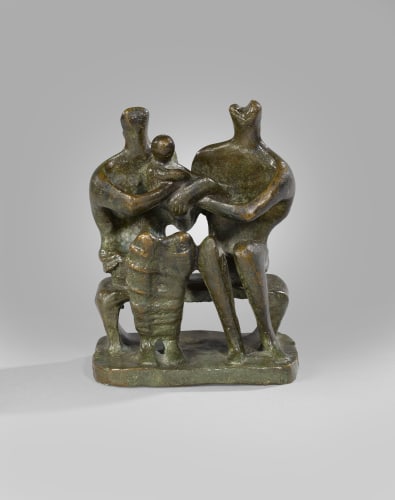Henry Moore was born on 30 July 1898, in Castleford, Yorkshire. After the First World War, Moore studied at Leeds School of Art in 1919 and the Royal College of Art in London in 1921, where he would go on to teach. In 1924, he took part in his first group exhibition at the Redfern Gallery, London, and had his first solo exhibition at the Warren Gallery in 1928. Moore was swiftly developing a reputation as a Modernist sculptor of note and completed his first public commission, the carved relief of West Wind, for the façade of the new headquarters of the London Underground in 1929. Moore would also marry painter Irina Radetsky that year. The two moved to Hampstead, where their local neighbours included Marcel Breuer, Naum Gabo, Barbara Hepworth, László Moholy-Nagy, Paul Nash, Ben Nicholson, Roland Penrose and Herbert Read.
Moore’s reputation continued to grow throughout the 1930s, thanks to several public commissions and numerous exhibitions. He resigned from his post at the Royal College of Art in 1931, taking up a position at the Chelsea School of Art, which he held until 1939. During the Second World War, Moore became an Official War Artist and dedicated himself to drawing, creating his celebrated series of ‘shelter drawings’. In 1941, he was appointed a trustee of the Tate Gallery, a position he held intermittently until 1956. After the War, Moore and his wife decided to relocate to Hertfordshire permanently, settling in Perry Green, where they had been renting a farmhouse since 1940.
By this point, Moore was acclaimed as one of the leading sculptors of his generation. In 1946, he was the subject of a major retrospective at the Museum of Modern Art, New York. In 1948, Moore was the sole representative of the British Pavilion at the XXIV Venice Biennale, winning the International Prize for Sculpture, and he would represent Britain again at the Biennale in 1952. Now living in the countryside, Moore started to gradually absorb and integrate elements of the natural landscape into his practice, at times exploring the analogies with the human body. Meanwhile, his success saw him turn increasingly to bronze rather than the wood and stone of his work from 1930s and 1940s – a product of his improved financial means.
Moore continued to work until his death, executing major commissions in his later life, including the marble Reclining Figure, 1957-58, for the UNESCO headquarters in Paris, and Nuclear Energy, 1964-66, for the University of Chicago. The British Council organised a major retrospective of his work in Florence (1972), and a touring retrospective in Madrid, Lisbon, and Barcelona (1981). In 1977, Moore established the Henry Moore Foundation to exhibit and manage his estate. Moore died in Perry Green on 31 August 1986.
Moore’s work can be found in the following selected international collections: the Museum of Modern Art (MoMA), New York; the Metropolitan Museum of Art, New York; Solomon R. Guggenheim Museum, New York; Art Institute of Chicago; Albright-Knox Art Gallery, Buffalo; Philadelphia Museum of Art; San Francisco Museum of Modern Art (SFMoMA); Los Angeles County Museum of Art (LACMA); Museo Nacional de Bellas Artes, Buenos Aires; the Peggy Guggenheim Collection, Venice; Stedelijk Museum, Amsterdam; Whitworth Art Gallery, Manchester; The Hepworth Wakefield, Leeds; the Tate Collection, London.
Please contact the gallery for further information on this artist.
